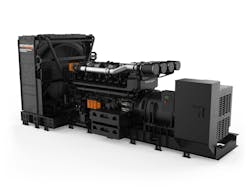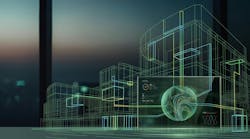Generac Sharpens Focus on Data Center Power with Scalable Diesel and Natural Gas Generators
In a digital economy defined by constant uptime and explosive compute demand, power reliability is more than a design criterion—it’s a strategic imperative. In response to such demand, Generac Power Systems, a company long associated with residential backup and industrial emergency power, is making an assertive move into the heart of the digital infrastructure sector with a new portfolio of high-capacity generators engineered for the data center market.
Unveiled this week, Generac’s new lineup includes five generators ranging from 2.25 MW to 3.25 MW. These units are available in both diesel and natural gas configurations, and form part of a broader suite of multi-asset energy systems tailored to hyperscale, colocation, enterprise, and edge environments. The product introductions expand Generac’s commercial and industrial capabilities, building on decades of experience with mission-critical power in hospitals, telecom, and manufacturing, now optimized for the scale and complexity of modern data centers.
“Coupled with our expertise in designing generators specific to a wide variety of industries and uses, this new line of generators is designed to meet the most rigorous standards for performance, packaging, and after-treatment specific to the data center market,” said Ricardo Navarro, SVP & GM, Global Telecom and Data Centers, Generac.
Engineering for the Demands of Digital Infrastructure
Each of the five new generators is designed for seamless integration into complex energy ecosystems. Generac is emphasizing modularity, emissions compliance, and high-ambient operability as central to the offering, reflecting a deep understanding of the real-world challenges facing data center operators today.
The systems are built around the Baudouin M55 engine platform, which is engineered for fast transient response and high operating temperatures—key for data center loads that swing sharply under AI and cloud workloads. The M55’s high-pressure common rail fuel system supports low NOx emissions and Tier 4 readiness, aligning with the most stringent regulatory requirements, including those in critical data center markets like Northern Virginia.
Control systems are powered by the Deep Sea G8601 controllers, configurable for a wide range of mission-critical applications, while the Marathon DataMAX alternators deliver low-reactance output stability tailored to sensitive IT loads.
Additional features of the new platform include:
- Redundant starting systems with dual engine starters, battery sets, and chargers to eliminate single points of failure.
- 50°C-rated cooling packages, allowing deployment in high-ambient zones such as Phoenix, Dallas, or Southeast Asia.
- Configurable circuit breakers—offered in left and right-side options—scalable up to full generator amperage at 480V.
- Integrated enclosures, tanks, and switchboards, packaged in coordination with vendors experienced in the data center space.
Most notably, Generac is offering this platform with its Modular Power Systems (MPS) architecture, which enables multiple units to be paralleled and scaled using onboard controls. This gives operators the flexibility to expand power capacity in lockstep with IT demand, while maintaining redundancy and serviceability across the fleet.
“We’re seeing rapid growth in the construction of new data centers by hyperscalers and cloud service providers, which is fueled by the explosion of AI and an unprecedented surge in energy demand,” said Brad Meissner, Director of Product Management for industrial stationary generators at Generac.
Speed to Market, in a Constrained Supply Chain
In a market where AI is accelerating the pace of construction and expanding power densities, procurement speed can make or break a project timeline. Generac is positioning its 50–60 week lead time as a key differentiator—shorter than many industry norms that now stretch into 70–90 weeks due to supply chain constraints in power systems and switchgear.
The company credits its diversified and vertically integrated supply chain for this agility. It’s a strategic advantage built through recent acquisitions and investment in logistics flexibility—critical at a time when Tier 1 data center developers are racing to deliver capacity in Northern Virginia, the Midwest, and emerging AI zones like Atlanta and New Albany, Ohio.
“Our ability to adjust production to market demand allows us to provide shorter lead times, which enables faster deployment and helps reduce downtime,” said Meissner.
Meeting the Regulatory Moment
As scrutiny grows around the carbon footprint of digital infrastructure, diesel generation is increasingly caught between reliability and regulation. Generac is responding with a power lineup designed for compliance, particularly in jurisdictions like Virginia and California where backup generators face intense permitting requirements.
All five new units from Generac are ready for Tier 4 after-treatment systems and are engineered to support low-emissions operations, minimizing the compliance burden for data center operators. The company says the engines’ fuel systems and exhaust management architecture are specifically optimized for clean operation, supporting both environmental goals and permitting efficiency.
While diesel remains the dominant fuel for backup today—95% of operators still rely on it, according to Uptime Institute—interest is growing in alternatives. Generac’s inclusion of natural gas generator options signals a recognition that energy diversification is becoming a strategic concern, particularly in edge, urban, or carbon-sensitive deployments.
Energy Ecosystems and the Future of Standby
Beyond just generators, Generac is moving toward multi-asset energy systems—a concept that aligns closely with the evolving needs of modern data centers. As operators explore hybrid solutions that blend backup generation with battery storage, load management, and even on-site renewables, the ability to integrate systems across the energy stack will be key.
This approach reflects an industry trend toward distributed energy resiliency, where the power infrastructure is not just a safety net, but a dynamic asset that enables grid participation, demand response, and sustainability metrics.
Poised for the AI Era
Generac’s deepened focus on the data center market arrives at a moment of dramatic industry transformation. AI workloads are supercharging demand forecasts, with analysts like McKinsey projecting North American data center power demand could double by 2030, reaching over 35 GW.
As grid volatility, extreme weather, and permitting complexity converge with this growth, the need for resilient, emissions-compliant backup systems has never been more urgent.
Generac’s latest offering—a blend of scale, compliance, configurability, and speed—aims to offer a pragmatic answer to that challenge. Whether in hyperscale campuses or urban edge sites, the company is betting that its combination of proven platforms and flexible deployment models can power the next generation of digital infrastructure.
The Road Ahead
Generac’s entry into the upper tier of the data center generator market marks a continuation of its strategic pivot beyond residential and light-commercial power.
The company has quietly assembled a war chest of industrial energy technologies—backed by acquisitions like that of Enbala and Off Grid Energy—and now appears ready to scale those capabilities across one of the fastest-growing infrastructure verticals in the world.
As AI continues to reshape what’s required of modern digital infrastructure, backup power solutions like Generac’s will remain a cornerstone of reliability—and a key differentiator for operators navigating the next wave of data center growth.
At Data Center Frontier, we talk the industry talk and walk the industry walk. In that spirit, DCF Staff members may occasionally use AI tools to assist with content. Elements of this article were created with help from OpenAI's GPT4.
Keep pace with the fast-moving world of data centers and cloud computing by connecting with Data Center Frontier on LinkedIn, following us on X/Twitter and Facebook, as well as on BlueSky, and signing up for our weekly newsletters using the form below.
About the Author
Matt Vincent
A B2B technology journalist and editor with more than two decades of experience, Matt Vincent is Editor in Chief of Data Center Frontier.



